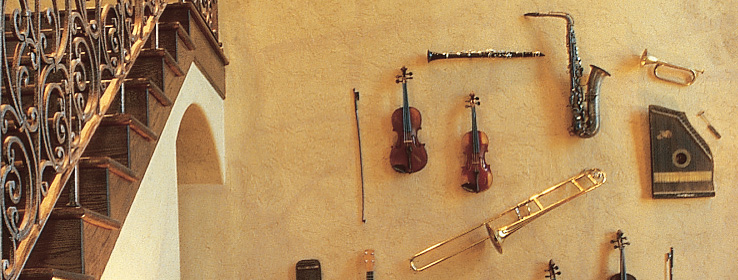Jazz composer Maria Schneider riffs on her music and the hues it evokes.
Talking jazz with composer Maria Schneider makes for a colorful conversation, filled with vibrant, visual analogies about instrument palettes, tone shadings and even the nature of plaid. I see music as a very visual thing, she says. Her rich, layered compositions have won worldwide acclaim, as well as many jazz critic and reader poll accolades, and most recently a Grammy award in 2005 (Best Large Jazz Ensemble Recording) for Concert in the Garden.
MS
Sound is vibration, and color is vibration. In the music world, we always talk about tone color, which I see as a cross between color and texture. Different instruments have different brilliance, and when I do concerts, certain music seems to inspire certain colors. I have a song "Greenpiece” that is very pastoral. When I was touring Europe, nobody knew the name of what I was playing, but when I started that song, they bathed the band in green light. I have another song about sailing called "Coming About,” and invariably, they put us in a blue light for that one. There must besomething about the timbre of the instruments.
MS
I see the trumpet as red, the trombone as yellow and the saxophone as blue.
MS
I like to mix sounds to create texture. When I was a kid, I wanted the big box of Crayolas with the pencil sharpener, the one with 72 colors. Mom made us get the small box because she wanted us to mix our own colors. I'm still doing that. I try to get the color of a bassoon, but rather than using a bassoon, I'll do it by mixing other instruments and mutes. Like the French horn. The color of the French horn is a very beautiful, warm burnt orange. I don't have that instrument in my band, but I can get that sound by mixing a bucket mute trombone with a clarinet.
MS
When you look at a plaid shirt, you don't notice where the colors intersect. You notice the orange and green stripes, not the greeny-brown in the middle. Music is about line, and in jazz composition, you're concerned about vertical sound at any one moment. If two lines converge in an uncomfortable way, if it's a little off, it's good. It propels you to keep listening. You want that resolution.
MS
Color in a room makes you feel a certain way. It generates heat, cool, intensity. It makes people feel emotion in certain ways. Colors in music do the same thing. There's a hue to the sound that affects you the same way color affects you in a room. If you see green leaves and a red flower, they're vibrating with contrast. One intense color against another can almost repel. But you're also attracted. You can do the same thing musically.
MS
I sit at my piano, so it's a brown floor and a black piano. But I have a lot of orange in my apartment. I love orange! When I was a kid we used to go to Mexico, and the color of the clay there is so vibrant against the black wrought iron. The wall of my bedroom is red, the color of that natural clay.
It was hard to find that color, and it was so important to me to get the right shade, so I mixed it myself. People say it's not good to have a red bedroom because you can't sleep, and I agree. It took so long to get the right color that I don't want to get rid of it, but I don't sleep well at all. Color really does things to your body.
MS
"Prelude to the Afternoon of a Faun” by Debussy.
MS
Something by [Edgard] Varese, an electronic composer.
MS
Flamenco music. Southern and warm.
MS
I started composing when I was a child. Growing up [in Windom, Minn.], I never really met any composers, and I didn't presume that I could become one. But I was gifted with a really good piano teacher. She was an amazing musician, and she had red hair — so did I. When she came to our house and sat down and played, that's when my life came into living color, just like in "The Wizard of Oz.” It was like color was flying above the piano and floating. I was transfixed.
MS
Even from the first lesson, she wanted me to understand how tones are put together. She made me analyze every piece, every chord. I think that's why I became a composer, and not a performer. I loved the architecture of music, what it was, not what I was giving it. Composing is like looking inside a musical hologram. That's why I do it.







